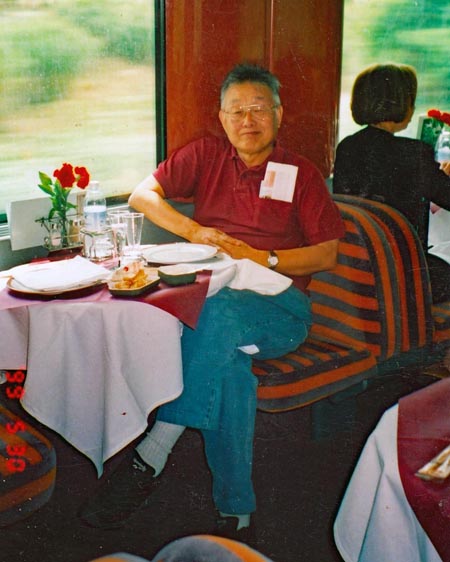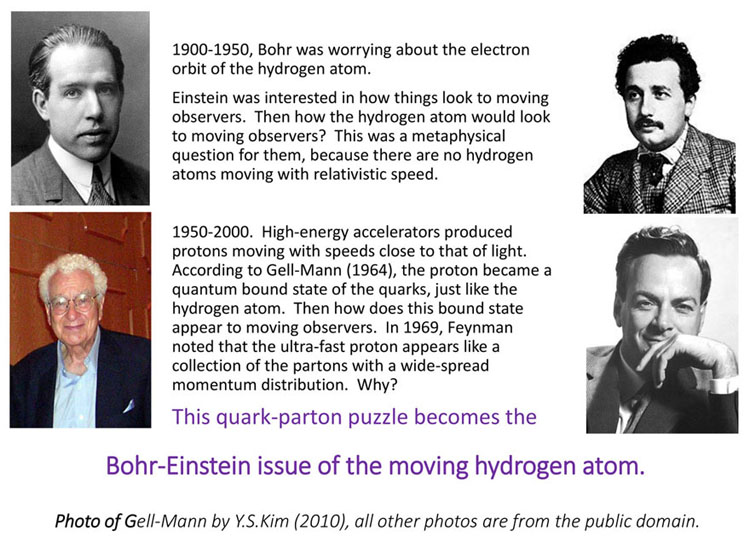Bohr and Einstein on the Hydrogen Atom

|
on an Italian train from Naples to Rome (1999), wondering
how the world appears to a moving observer, as Einstein did.
|
|
Here comes the most cruel question in physics.
Does this figure have anything to with what we see in the real world?
- We have the following problems.
- There are no trains moving fast enough to show this Einstein effect.
- How about fast-moving hydrogen atoms. The hydrogen atoms are neutral particles.
Particle detectors cannot detect them.
- What should we do about this problem?
- After 1950 (after the era of Bohr and Einstein), particle accelerators routinely
produced protons moving with speeds comparable with that of light. However, the
proton is not hydrogen atom.
- In 1964,
Murray Gell-Mann invented the quark model. According to this model, the
proton is a quantum bound state of more fundamental particles called the
quarks. This proton
shares the same quantum mechanics of bound state with that of the hydrogen atom.
- In 1969, Richard Feynman
observed that Gell-Mann's proton, when it moves with a velocity close to that of light,
appears like
a collection of the partons whose properties are quite different from
those of the quarks.
- Thus, the quark-parton puzzle becomes the question of moving quantum
bound states in Einstein's Lorentz-covariant world, as in the case
of moving hydrogen atoms. In other words, we can resolve the issue of
moving hydrogen atom by providing a solution to the quark-parton puzzle.

- Click here for a more extensive
discussion on this issue.
- Let us go back to Einstein. While he was a high school student, he became interested
in the philosophy of
Immanuel Kant, saying that a given object could appear differently
depending on the observer's environment or status of mind.

|
He appears differently viewed from different angles. How would
he appear to moving observers?
|
- The best way to illustrate the Kantian view of the world is to look at a statue of
Japan's Toyotomi Hideyosi.
Toyotomi is a very important person in Japanese history. In 1600 AD, he unified Japan by
brutally eliminating the rival war lords.
He is a monkey (O-Saru San in Japanese) to human eyes, while he is a human when monkeys look at him.
- If your name is Einstein, you could ask how he appears to a moving observer?
If the monkey is too complicated, let us choose the simplest object: the hydrogen atom.
How would the hydrogen atom appear to a moving observer? We thus return to the original
Einsteinian question.
- Let us come back to the hydrogens and protons. The elementary particles are known to have
internal space-time structures. What does the "internal" mean?
Click here.
The electron at rest spins around, and its direction is
anywhere in the three dimensional space. The photon with its zero mass is moving with the
velocity of light, but its spin direction is either parallel or anti-parallel to the momentum.
Eugene Paul Wigner (1902-1995) of Princeton University wrote his paper in 1939 showing why
they are so.
This leads to the question of energy-momentum relation between momentum and energy. For
the massive particle, it is E = P2/2m, while it is E = cp.
Einstein's special relativity gives one formula for both, as is well known.
Therefore, the internal space-time symmetries should be so unified. Indeed, I worked hard
with my younger colleges on this issue, and published our papers in 1983 and 1986, containing
with my younger colleges on this issue, and published our papers in 1983 and 1986, containing
this table:
| |
Energy
Momentum |
E=p2/2m |
Einstein's
E=(m2 + p2)1/2 |
E = cp |
|
Helicity
Spin, Gauge |
S3
S1
S2 |
Wigner's
1939 paper |
S3
Gauge Trans. |
|
In 1986, I went to Princeton and showed this table to Professor Wigner. He became
so happy to see this result, and asked me to write papers with him.
Click here for detailed stories.
- Let us come back to the moving hydrogen issue. In earlier years, with
Marilyn Noz starting from 1973, I published many papers on wave functions for the
harmonic oscillator in Einstein's Lorentz-covariant world.
- We used this covariant
harmonic oscillator wave functions to answer the quark-parton puzzle and published
the paper in 1977.
We can summarize our result as

- This result can be added to the above Einstein-Wigner table. I published
a paper in Physical Review Letters containing this table:
| |
Energy
Momentum |
E=p2/2m |
Einstein's
E=(m2 + p2)1/2 |
E = cp |
|
Helicity
Spin, Gauge |
S3
S1
S2 |
Wigner's
1939 paper |
S3
Gauge Trans. |
|
Hadrons,
Bound States |
Gell-Mann's
Quark Model |
One
Lorentz-Covariant
Entity |
Feynman's
Parton Picture |
|
This table is from
my PRL paper published in 1989.
Since I made a contribution to the 3rd row (purple) of this table,
I am known as Wigner's student in the physics community.
Click here for the story.
|
- This table can be translated into

|
|